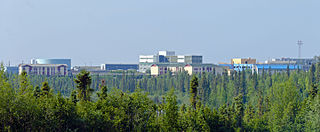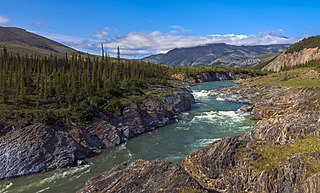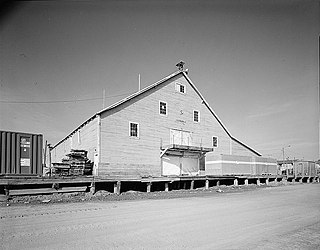
The reindeer, also known as caribou in North America, is a species of deer with circumpolar distribution, native to Arctic, sub-Arctic, tundra, boreal, and mountainous regions of northern Europe, Siberia, and North America. This includes both sedentary and migratory populations. This is the only species in the genus Rangifer. Its herd size varies greatly in different geographic regions.

Inuvik is the only town in the Inuvik Region, and the third largest community in Canada's Northwest Territories. Located in what is sometimes called the Beaufort Delta Region, it serves as its administrative and service centre and is home to federal, territorial, and Indigenous government offices, along with the regional hospital and airport.

Aklavik is a hamlet located in the Inuvik Region of the Northwest Territories, Canada. Until 1961, with a population over 1,500, the community served as the regional administrative centre for the territorial government.
Inuvialuktun comprises several Inuit language varieties spoken in the northern Northwest Territories by Canadian Inuit who call themselves Inuvialuit. Some dialects and sub-dialects are also spoken in Nunavut.

The Inuvialuit or Western Canadian Inuit are Inuit who live in the western Canadian Arctic region. They, like all other Inuit, are descendants of the Thule who migrated eastward from Alaska. Their homeland – the Inuvialuit Settlement Region – covers the Arctic Ocean coastline area from the Alaskan border, east through the Beaufort Sea and beyond the Amundsen Gulf which includes some of the western Canadian Arctic Islands, as well as the inland community of Aklavik and part of Yukon. The land was demarked in 1984 by the Inuvialuit Final Agreement.

The Gwichʼin are an Athabaskan-speaking First Nations people of Canada and an Alaska Native people. They live in the northwestern part of North America, mostly above the Arctic Circle.

Tuktoyaktuk, or TuktuyaaqtuuqIPA: [təktujaːqtuːq], is an Inuvialuit hamlet located in the Inuvik Region of the Northwest Territories, Canada, at the northern terminus of the Inuvik–Tuktoyaktuk Highway. Tuktoyaktuk, one of six Inuvialuit communities in the Inuvialuit Settlement Region, is commonly referred to simply by its first syllable, Tuk. The settlement lies north of the Arctic Circle on the shores of the Arctic Ocean, and is the only community in Canada on the Arctic Ocean that is connected to the rest of Canada by road. Formerly known as Port Brabant, the community was renamed in 1950 and was the first place in Canada to revert to the traditional Indigenous name.
The Anderson River is in the Northwest Territories in northern Canada. It originates in lakes northwest of Great Bear Lake; its headwaters are possibly on the north side of Colville Lake in the vicinity of the hamlet of Colville Lake. It flows north and west in the area between the Mackenzie and Coppermine Rivers. Its mouth is on the Beaufort Sea on the Arctic Ocean near the eastern end of Liverpool Bay at about 70 degrees north latitude. Its main tributary is the Carnwath River. Originally known as the Beghula River it was renamed to the Anderson River in 1857 by Roderick MacFarlane after James Anderson, both of the Hudson's Bay Company. Anderson was the Chief Factor in the Mackenzie District.

Ivvavik National Park is a national park of Canada located in Yukon. Initially named "Northern Yukon National Park," the park was renamed Ivvavik in 1992 for the Inuvialuktun word meaning "nursery" or "birthplace," in reference to the importance of the area as a calving ground for Porcupine caribou. Created as a result of the Inuvialuit Final Agreement in 1984, negotiated between the Canadian Government and the Inuvialuit of the Northern Yukon, Ivvavik is the first national park in Canada to be established as a result of an aboriginal land claims agreement. About 100 people visit the park each year.

Tuktut Nogait National Park is a national park located in the Northwest Territories of Canada that was established in 1998. Meaning "young caribou" in Inuvialuktun, the park is home to the calving grounds of the Bluenose-West caribou herd.

Uummarmiutun, Uummaġmiutun or Canadian Iñupiaq is the variant of Iñupiaq spoken by the Uummarmiut, part of the Inuvialuit, who live mainly in the communities of Inuvik and Aklavik in the Northwest Territories of Canada.

The Porcupine caribou or Grant's caribou is a subspecies of the reindeer or caribou found in Alaska, United States, and Yukon and the Northwest Territories, Canada. It resembles the subspecies known as the barren-ground caribou and is sometimes included in it.
The Mackenzie Valley Pipeline, also called the Mackenzie River Pipeline, was a proposed project to transport natural gas from the Beaufort Sea through Canada's Northwest Territories to tie into gas pipelines in northern Alberta. The project was first proposed in the early 1970s but was scrapped following an inquiry conducted by Justice Thomas Berger. The project was resurrected in 2004 with a new proposal to transport gas through the sensitive arctic tundra. Probabilistic estimates of hydrocarbons in the Mackenzie Delta and Beaufort Sea regions project that there are natural gas reserves of 1.9 trillion cubic metres. After many delays, the project was officially abandoned in 2017 by the main investment partners citing natural gas prices and the long regulatory process.

The barren-ground caribou is a subspecies of the reindeer that is found mainly in the Canadian territories of Nunavut and the Northwest Territories, as well as in Kitaa, Greenland. It sometimes includes the similar-looking Porcupine caribou, in which case the barren-ground caribou is also found in Alaska. The barren-ground caribou is a medium-sized caribou, smaller and lighter-coloured than the boreal woodland caribou, with the females weighing around 90 kg (200 lb) and the males around 150 kg (330 lb). However, on some of the smaller islands, the average weight may be less. The large migratory herds of barren-ground caribou take their names from the traditional calving grounds, such as the Ahiak herd, the Baffin Island herds, the Bathurst herd, the Beverly herd, the Bluenose East herd, the Bluenose West herd, the Porcupine herd and the Qamanirjuaq herd.

The Nunamiut or Nunatamiut are semi-nomadic inland Iñupiat located in the northern and northwestern Alaskan interior, mostly around Anaktuvuk Pass, Alaska.

The Inuvialuit Settlement Region, abbreviated as ISR, located in Canada's western Arctic, was designated in 1984 in the Inuvialuit Final Agreement by the Government of Canada for the Inuvialuit people. It spans 90,650 km2 (35,000 sq mi) of land, mostly above the tree line, and includes several subregions: the Beaufort Sea, the Mackenzie River delta, the northern portion of Yukon, and the northwest portion of the Northwest Territories. The ISR includes both Crown Lands and Inuvialuit Private Lands.

Lomen Company was an American meatpacking industry, founded in 1914 by brothers Carl and Alfred Lomen in the then Territory of Alaska.

Indigenous peoples of the Subarctic are the aboriginal peoples who live in the Subarctic regions of the Americas, Asia and Europe, located south of the true Arctic. This region includes the interior of Alaska, the Western Subarctic or western Canadian Shield and Mackenzie River drainage area, the Eastern Subarctic or Eastern Canadian Shield, Scandinavia, Western Russia and East Asia. Peoples of subarctic Siberia and Greenland are included in the subarctic; however, Greenlandic Inuit are usually classified as Indigenous peoples of the Arctic.

Alaska Reindeer Service (ARS) was established for the benefit of the U.S. territory of Alaska by Congressional action on 3 March 1893. The ARS was an integral part of the educational system of northern and western Alaska. The superintendent of education of Alaska Natives had general supervision of the work. The district superintendents in northern and western Alaska were supervisors of the reindeer industry within their districts. The first annual expenditure for the period of 1893-94 was US$5,998.

The reindeer is a widespread and numerous species in the northern Holarctic, being present in both tundra and taiga. Originally, the reindeer was found in Scandinavia, eastern Europe, Russia, Mongolia, and northern China north of the 50th latitude. In North America, it was found in Canada, Alaska, and the northern contiguous USA from Washington to Maine. In the 19th century, it was apparently still present in southern Idaho. It also occurred naturally on Sakhalin, Greenland, and probably even in historical times in Ireland. During the late Pleistocene era, reindeer were found further south, such as at Nevada, Tennessee, and Alabama in North America and Spain in Europe. Today, wild reindeer have disappeared from many areas within this large historical range, especially from the southern parts, where it vanished almost everywhere. Populations of wild reindeer are still found in Norway, Finland, Siberia, Greenland, Alaska, and Canada.




















